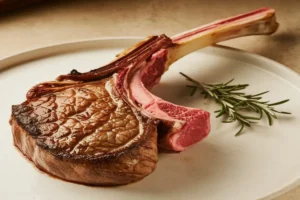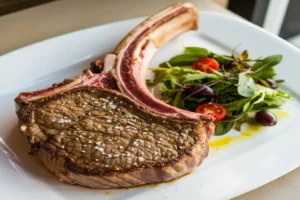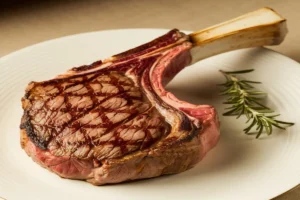Introduction
Tomahawk steak is more than just a piece of meat; it’s an experience, a statement, and a celebration of culinary craftsmanship. This cut of beef is renowned for its impressive presentation and exceptional flavor. Its unique appearance, characterized by a long, frenched bone, has made it a star on the grill and a favorite among steak enthusiasts. But what exactly makes the tomahawk steak so special? In this article, we will delve into the origins, preparation, cooking techniques, and the cultural significance of the tomahawk steak. By the end, you’ll understand why this cut of meat is not just another steak but a symbol of indulgence and expertise in the culinary world.
The Origins and History of the Tomahawk Steak
The tomahawk steak traces its roots back to the primal cuts of beef, specifically the ribeye. The ribeye is one of the most prized cuts due to its marbling, tenderness, and flavor. The tomahawk steak is essentially a bone-in ribeye, but what sets it apart is the extra-long bone left intact. This bone, usually about 6 to 8 inches long, is frenched, meaning the meat and fat are trimmed away to expose the bone, creating a handle that resembles a tomahawk axe—hence the name.
Historically, the tomahawk steak is a modern creation in the culinary world. While ribeye steaks have been enjoyed for centuries, the tomahawk as we know it became popular in fine dining restaurants and among steak enthusiasts in the late 20th and early 21st centuries. The presentation and dramatic appearance of the steak played a significant role in its rise to fame. Chefs began to recognize the visual appeal of the long bone and its potential to elevate the dining experience.
The Cultural Significance of Tomahawk Steak

In many cultures, sharing a meal is a significant event, and the tomahawk steak has become a centerpiece for such occasions. The steak’s size and presentation make it ideal for sharing, and it often appears at celebratory meals, from family gatherings to upscale restaurant dinners. The tomahawk steak embodies the essence of communal dining, where the act of cutting into the large, juicy steak becomes a shared experience.
Moreover, the tomahawk steak has been embraced by the “foodie” culture, where presentation and social media presence are as important as taste. The steak’s imposing size and photogenic qualities have made it a popular subject for food bloggers, Instagrammers, and culinary influencers. In this way, the tomahawk steak has transcended its role as mere food, becoming a symbol of indulgence and luxury in the modern dining landscape.
The Anatomy of a Tomahawk Steak
To truly appreciate the tomahawk steak, it’s essential to understand its anatomy. The steak is cut from the rib section of the cow, specifically from the rib primal. This area is known for producing some of the most flavorful and tender cuts of beef, including the ribeye and prime rib.
The Ribeye
At the heart of the tomahawk steak is the ribeye, which is widely regarded as one of the best cuts of beef. The ribeye is prized for its marbling—the intramuscular fat that runs through the meat, giving it its characteristic flavor and juiciness. When cooked, the marbling melts, infusing the meat with rich, beefy flavors that are hard to match.
The Bone
The defining feature of the tomahawk steak is the long, frenched bone. This bone is not only for show; it also plays a role in the cooking process. The bone helps to insulate the meat as it cooks, leading to a more even distribution of heat and a juicier steak. Additionally, the bone adds a unique flavor to the meat, particularly when grilled or roasted.
The Size
Tomahawk steaks are large—typically weighing between 30 to 45 ounces, including the bone. This size makes them ideal for sharing, although some steak aficionados may prefer to tackle one on their own. The thickness of the steak, usually around 2 inches, allows for a perfect sear on the outside while keeping the interior tender and juicy.
How to Choose the Perfect Tomahawk Steak

Choosing the perfect tomahawk steak is the first step toward an unforgettable dining experience. Here are some tips to ensure you select the best cut:
Marbling
Look for a steak with abundant marbling. The fat should be evenly distributed throughout the meat, as this will ensure a flavorful and juicy steak. USDA Prime or Wagyu tomahawk steaks are known for their superior marbling.
Color
The meat should be a bright, cherry-red color. This indicates that the steak is fresh and of high quality. Avoid steaks that have a brownish hue, as this may be a sign of aging or improper storage.
Bone Length
The length of the bone is also an important factor. A longer bone not only adds to the steak’s dramatic presentation but also contributes to the flavor and cooking process. Ensure that the bone is well-frenched, with no excess fat or meat clinging to it.
Thickness
The ideal tomahawk steak should be at least 2 inches thick. This thickness allows for a perfect balance between a seared crust and a tender, juicy interior. Thinner steaks may cook too quickly, resulting in an overcooked exterior and undercooked interior.
The Art of Cooking a Tomahawk Steak
Cooking a tomahawk steak is both an art and a science. The goal is to achieve a perfect sear on the outside while maintaining a juicy, tender interior. There are several methods to cook a tomahawk steak, but the most popular include grilling, pan-searing, and oven-roasting.
Grilling
Grilling is perhaps the most traditional method for cooking a tomahawk steak. The open flame imparts a smoky flavor that complements the beef’s natural richness. Here’s how to grill a tomahawk steak to perfection:
- Preparation: Take the steak out of the refrigerator at least an hour before cooking to bring it to room temperature. This ensures even cooking.
- Seasoning: Season the steak generously with kosher salt and freshly ground black pepper. You can also add garlic powder, onion powder, or your favorite steak seasoning blend.
- Searing: Preheat your grill to high heat. Sear the steak directly over the flames for 2-3 minutes per side, until a crust forms.
- Indirect Cooking: Move the steak to a cooler part of the grill and continue cooking over indirect heat. Close the grill lid and cook for 20-30 minutes, turning the steak occasionally. Use a meat thermometer to check the internal temperature. For medium-rare, aim for 130-135°F.
- Resting: Once the steak reaches your desired doneness, remove it from the grill and let it rest for 10-15 minutes. This allows the juices to redistribute throughout the meat, ensuring a juicy steak.
Pan-Searing and Oven-Roasting
If you don’t have access to a grill, pan-searing followed by oven-roasting is an excellent alternative. This method allows for precise control over the cooking process, ensuring a perfectly cooked steak every time.
- Preparation: Similar to grilling, bring the steak to room temperature before cooking.
- Seasoning: Season the steak with salt, pepper, and any other desired spices.
- Searing: Heat a cast-iron skillet over high heat and add a tablespoon of high-smoke-point oil, such as canola or grapeseed oil. Sear the steak for 2-3 minutes per side until a golden-brown crust forms.
- Roasting: Transfer the skillet to a preheated oven at 375°F. Roast the steak for 15-20 minutes, or until the internal temperature reaches 130-135°F for medium-rare.
- Resting: Let the steak rest for 10-15 minutes before slicing.
Sous-Vide
For those who prefer precision, sous-vide is an excellent method for cooking a tomahawk steak. This technique involves vacuum-sealing the steak and cooking it in a water bath at a controlled temperature. Sous-vide ensures even cooking from edge to edge and locks in moisture.
- Preparation: Season the steak and place it in a vacuum-sealed bag with a sprig of rosemary, thyme, and a clove of garlic.
- Cooking: Set your sous-vide machine to 130°F for medium-rare and cook the steak for 2-4 hours.
- Searing: After sous-vide, sear the steak in a hot cast-iron skillet for 1-2 minutes per side to develop a crust.
- Resting: Allow the steak to rest for a few minutes before serving.
Pairing a Tomahawk Steak with Wine and Sides

A tomahawk steak is a rich, flavorful cut of meat, and it pairs beautifully with certain wines and side dishes that complement its robust taste.
Wine Pairings
- Cabernet Sauvignon: This full-bodied red wine is a classic pairing for steak. Its high tannin content cuts through the richness of the tomahawk, while its dark fruit flavors enhance the beef’s natural sweetness.
- Malbec: Another excellent choice, Malbec offers a balance of fruit and acidity that complements the steak’s marbling. Its deep, velvety texture mirrors the luxurious mouthfeel of the steak.
- Zinfandel: For those who prefer a spicier wine, Zinfandel is an excellent match. Its bold flavors and peppery notes bring out the steak’s savory qualities.
Side Dishes
- Garlic Mashed Potatoes: Creamy and rich, garlic mashed potatoes are the perfect foil for the intense flavors of the tomahawk steak.
- Grilled Asparagus: The slight bitterness of grilled asparagus provides a nice contrast to the steak’s richness, while the charred edges add a complementary smoky flavor.
- Roasted Brussels Sprouts: With their crispy exterior and tender interior, roasted Brussels sprouts bring a nutty, earthy flavor that pairs well with the tomahawk.
- Caesar Salad: A classic Caesar salad with its crisp romaine, tangy dressing, and crunchy croutons offers a refreshing counterpoint to the hearty steak.
Nutritional Insights and Health Benefits
Tomahawk steak, like other cuts of beef, is rich in essential nutrients such as protein, iron, and zinc. However, it’s also important to be mindful of portion sizes and overall fat content.
Protein Powerhouse
A tomahawk steak is an excellent source of high-quality protein, which is essential for muscle growth and repair. A typical serving of tomahawk steak can provide up to 50 grams of protein, making it an ideal choice for those looking to increase their protein intake.
Iron and Zinc
Beef is a well-known source of heme iron, which is more easily absorbed by the body than non-heme iron found in plant-based foods. Iron is crucial for transporting oxygen in the blood, and a tomahawk steak can help meet daily iron requirements, especially for those at risk of deficiency.
Zinc, another essential mineral found in beef, plays a role in immune function, wound healing, and DNA synthesis. A single serving of tomahawk steak can contribute significantly to the daily recommended intake of zinc.
Fat Content
While tomahawk steak is rich in nutrients, it is also high in fat, particularly saturated fat. It’s important to enjoy this cut of meat in moderation, especially for those managing cholesterol levels. Trimming excess fat and opting for leaner portions can help reduce overall fat intake.
Vitamins
Tomahawk steak is also a good source of several B vitamins, including B12, which is essential for nerve function and the production of DNA and red blood cells. A deficiency in B12 can lead to anemia and neurological issues, making beef an important dietary source for those who do not consume other animal products.
Common Mistakes to Avoid When Cooking Tomahawk Steak
Cooking a tomahawk steak to perfection requires attention to detail. Here are some common mistakes to avoid:
Not Bringing the Steak to Room Temperature
Cooking a steak straight from the fridge can result in uneven cooking. The exterior may cook too quickly, while the interior remains undercooked. Always allow the steak to come to room temperature before cooking.
Overcooking
Given the thickness of the tomahawk steak, it’s easy to overcook the exterior while the interior remains underdone. Use a meat thermometer to monitor the internal temperature and avoid overcooking.
Skimping on Seasoning
The tomahawk steak’s size and flavor profile require generous seasoning. Don’t be afraid to use plenty of salt and pepper, and consider adding herbs and spices to enhance the flavor.
Neglecting the Resting Period
After cooking, it’s crucial to let the steak rest. This allows the juices to redistribute, resulting in a juicier steak. Cutting into the steak too soon can cause the juices to run out, leaving the meat dry.
Frequently Asked Questions (FAQs)
What Makes a Tomahawk Steak Different from a Ribeye?
While a tomahawk steak is technically a ribeye, the difference lies in the presentation. The tomahawk’s long, frenched bone and its larger size distinguish it from a standard ribeye. The bone also adds flavor and helps with even cooking.
How Many People Can a Tomahawk Steak Serve?
A typical tomahawk steak can serve 2-3 people, depending on portion sizes and side dishes. However, larger steaks can be shared among more people, making them ideal for family gatherings or special occasions.
Can I Cook a Tomahawk Steak in the Oven?
Yes, you can cook a tomahawk steak in the oven. After searing it on the stovetop, transfer it to a preheated oven to finish cooking. This method allows for precise control over the steak’s doneness.
Is Tomahawk Steak Expensive?
Tomahawk steak is generally more expensive than other cuts of beef due to its size, presentation, and the labor-intensive process of frenching the bone. However, many find the experience and flavor worth the extra cost.
How Do I Store Leftover Tomahawk Steak?
Leftover steak should be wrapped tightly in aluminum foil or plastic wrap and stored in the refrigerator. It can last up to 3-4 days. To reheat, gently warm the steak in the oven to avoid drying it out.
Conclusion
The tomahawk steak is more than just a meal; it’s a culinary experience that combines flavor, presentation, and tradition. Its rich history, dramatic appearance, and delicious taste make it a standout choice for special occasions or when you want to impress your guests. Whether you’re grilling it to perfection or roasting it in the oven, the tomahawk steak is sure to be a memorable centerpiece at any meal. By following the tips and techniques outlined in this article, you can ensure that your tomahawk steak is cooked to perfection, providing a mouthwatering experience that will leave everyone at the table satisfied.

